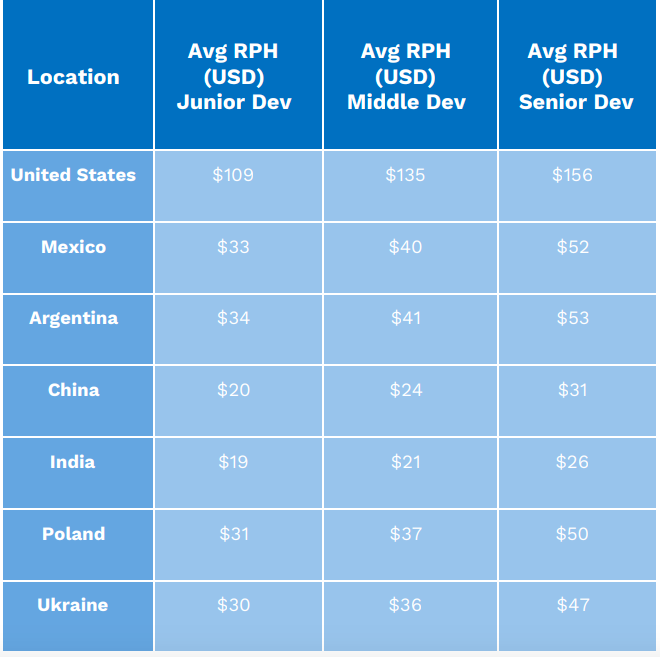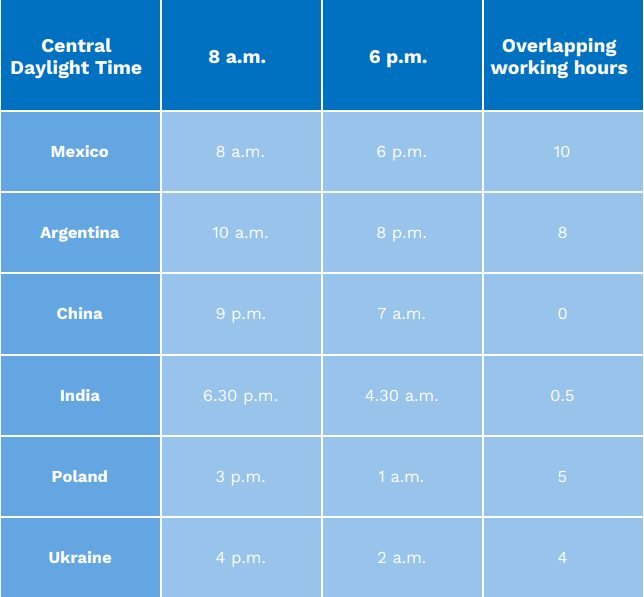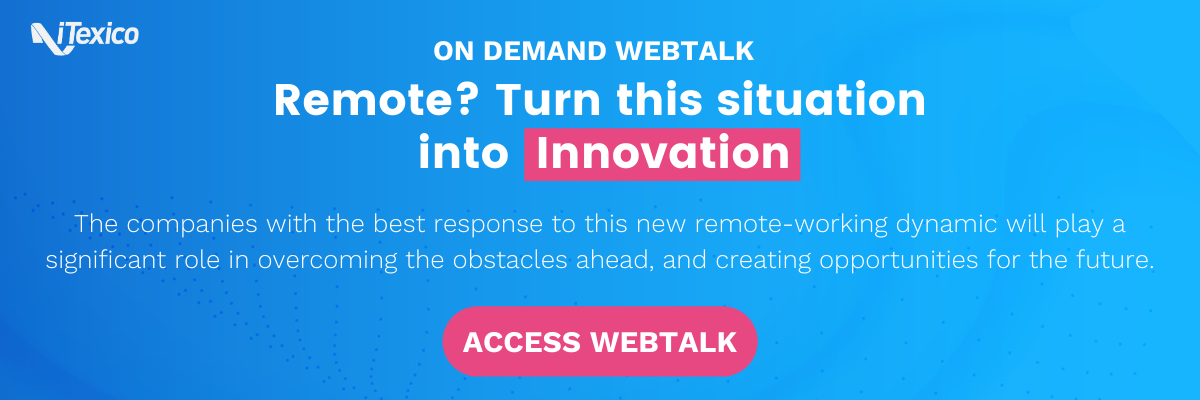Where do U.S. Companies Outsource Software Development?
Outsourcing has proven to be a resource of great popularity within the United States, as we will be more than willing to vouch for. Though it’s garnered somewhat of a negative connotation over the years, the reality stands as a monument to the truth: outsourcing is a prime driver behind engineering a successful and healthy business and economic model.
There are no industries without sin. Sports, charities, mining, filmmaking, whatever you can imagine is a product of imperfection. Humanity cannot wash our hands completely, but we can endeavor to pursue ethical, beneficial ends to the means, just as we at iTexico do. We create opportunities for advancement, job creation, and an improved quality of products for everyone involved to enjoy.
That’s the issue with reputation; it tends to rely heavily on hearsay. Ergo, the core tenets behind outsourcing are often misunderstood, such as where U.S. companies actually outsource their work to. China? India? The Philippines? Instead of randomly guessing, we’re going to talk a bit about where U.S. companies actually outsource to, why outsourcing is so cost-effectively functional, and what benefits are derived from a partnership like this.
Top Reasons for Outsourcing Software Development
Why do software development companies opt for outsourcing? We can start by understanding the reasons behind the high rates that U.S. companies will outsource software development. According to a recent report by Gartner, worldwide IT spending is expected to rise to $3.8 trillion in 2019, a 3.2 percent increase from the projected spending in 2018.
Those are fantastic numbers, and engineers seem to be the catalyst behind the increase. There’s presently a shortage of in-house engineering talent to spare for every software development company, centering it as one of the core reasons to outsource.
According to Statistics Brain, 43 percent of U.S. companies are outsourcing jobs from the IT industry. The top benefits for outsourcing according to the surveyed companies are:
- Cost savings (44%)
- Access to larger pools of IT talent (34%)
- Freeing up the workforce within the company (31%)
- Improvement of the company’s business and/or customer focus (28%)
- Fueling digital transformation (22%)
- Faster project development (15%)
- Access to the management expertise (15%)
- Reduction of time to market (9%)
Cost Savings
Getting the most bang for your buck is a hallmark notion that businesses need to abide by. Increasing the cost-savings amplitude for a company’s performance leads above all others as the driving factor for outsourcing. The fact that 44% of respondents agree, as outsourcing is not only much more affordable than hiring and training new employees to work on a short-term project, they’re just as likely to deliver on the high-quality products you’re looking for.
Access to Larger Pools of IT Talent
The United States has been experiencing a drought in IT talent recently, making our options for capable individuals limited, scarce. Compared to our small pond, branching out into other countries to draw on their reserves is like being given access to a lake, sea, or ocean full of potential team members.
Freeing Up the Workforce Within the Company
Outsourcing is an exercise in delegation, spreading up the workload to help increase efficiency. By keeping everything in-house, you’ll only have so much manpower to go around for handling every project that’s currently being produced or left waiting on the bench. Bringing in outside help means more hands to address those concerned projects, freeing up your employees that might have otherwise been constrained to work on other pressing core competencies.
Improvement of the Company’s Business and/or Customer Focus
A concept that goes hand-in-hand with proper delegation, with your attention less split between finishing all your projects on the table, you’re free to turn your focus to other properties. As a result, not only will your production rates increase with more projects being churned out, but acquiring new feedback from your customer’s while addressing their needs and concerns generates a positive image of your company, a net gain by any standard.
Fueling Digital Transformation
Digital technologies are the key that unlock the next stage of modern business. Transforming your business to adapt and leverage these technologies, however, is a process that remains ongoing in many organizations. Through outsourcing, you’ll be able to further fuel your digital transformation with a new labor pool of talent, core competencies refocusing, and dedicated, strategic transition from traditional business practices to modern digital activities.
Faster Project Development
An outsourced company is only going to have one thing to focus on: completing your project. The same can’t be said with confidence of your own in-house teams, as their attentions are likely to be torn between juggling several projects and competencies at once. With a devoted outsourcing team applied to a project, you can expect faster turnaround time.
Access to the Management Expertise
Those working at an outsourcing company are experienced employees with years of software development under their belt. The management skills derived from experience working on countless projects for a variety of companies will prove to be invaluable in a partnership.
Reduction of Time to Market
Software development is time consuming, and working out all the bugs and quirks in your code before it can be shipped off can be tedious and frustrating. With a dedicated outsourcing team on your project, the time spent on the overall time it takes between the completion of a project and sending it out to market is drastically cut down.
.png)
Source: Statista
The current demand outgrows the supply of qualified specialists for certain technologies, while some of the languages and frameworks are lagging behind. This means the IT job market is open for skilled employees. In the past years, however, developed countries face the lack of a qualified workforce, relying on outsourcing companies to find skilled professionals. Also, the unemployment rate of the IT industry is listed in the lowest positions. For example, the U.S. software engineering unemployment rate of 4% in 2011 declined to 1.9% in 2017.
.png)
Source: Global Sourcing Association
As you can see, these are a few of the most highly sought after skill sets that current U.S. software development companies are looking for. With a lack of desirable local candidates to fill these voids, the necessity for outsourced work increases.
Top Locations to Outsource Software Development
We have an entire globe full of potential software development partners to choose from, but that doesn’t mean they’re all going to be sourced from good labor pools. In order to maintain a good, steady relationship with an outsourcing company, you need to be sure that they’re going to be able to efficiently work with your organization. As such, there are a few locations that have proven to source good outsourcing partners.
Eastern Europe - Offshore
Eastern European countries are able to provide highly-skilled developers thanks to their high-quality education and a good level of English. There is a good cultural affinity, with European governments always supporting the IT sphere development. Biggest expenses for outsourcing companies in the U.S. come from long-hour business trips, considerable time difference, and higher hourly fees than other offshore destinations.
Ukraine
Ukraine has become the european country with the fastest developing IT industry with over 105,000 developers. The center of the industry is concentrated in the capital of Ukraine, Kyiv. Hourly rates range between $20-$45 an hour.
Poland
Poland offers over 118,000 IT specialists, and experience in outsourcing of a few decades. Most of them are located in Warsaw and Krakow. Poland offers some of the best services and operates inside the EEA economic zone, which is very convenient. However, that convenience comes at a cost and Poland is by far the most expensive IT outsourcing country in this list.
Asia and the Middle East - Offshore
This destination becomes attractive to U.S. companies when the most important factor for outsourcing is going for the lowest hourly fees. The geographical location is not that convenient with quite bigger time differences, communication issues stemming from low English proficiency and no cultural affinity. The unstable economic and political atmospheres of this region can also affect U.S. businesses. The number of outsourcing developers is one of the biggest compared with other destinations.
India
India is the leading country for offshore outsourcing with over 25 years experience and a huge pool of IT specialists. With one of the lowest prices ranging from $10-25/hour, cultural compatibility, and ease of business process are still the main issues.
China
China is improving both business and political environments, and advancing the quality of the services and skilled developers. Their hourly rates have been increasing in recent years, with an average of $30-40/hour.
Latin America - Nearshore
This destination has become the most attractive for US customers thanks to geographical proximity and lower fees. It allows high collaborative teaming. Latin American hourly rates can vary from $20 to $50. For more complete information on the differences between the shore types, feel free to read more about it in our article: Offshore, Onshore, Nearshore, What’s the Difference?
Mexico
Mexico offers reasonable service prices and a well-educated, growing workforce. Collaboration with US companies works well due to geographical proximity, and cultural affinity. The government is investing in improving their business environment in order to provide services for international companies. For a calculation for hiring nearshore companies, use our Nearshore Cost Calculator.
Argentina
Argentina is attractive thanks to having a culture highly influenced by Europe.
What Makes a Location a Hot Spot for Outsourcing?
Knowing the measure by which a location proves its worth as an outsourcing hot spot makes all the difference. As such, we wanted to provide further illumination into what defines a location as being an essential hot spot for outsourcing.
Gartner’s Checklist
Gartner is a global research and advisory firm that provides some of the best insights and information sources in all things business. When discussing the matter of choosing the correct software development services company, they broke down the process into a few cohesive steps to consider. Consider it a checklist before you make your final decision. Explore this checklist further through our interactive Decision Maker Guide.
1. Cost of Core Services
By no other measure, it’s a well established point that outsourcing work to a foreign country is leagues cheaper than outsourcing work to your local United States company. Opting for a U.S. outsourcing company may feel more comfortable, just by virtue of sharing the same soil, but even then it’s no guarantee that they’re going to deliver a better product than a cheaper alternative.
Your first step is to leverage the cost benefits and savings in a comparison between local, nearshore, and offshore outsourcing companies. Consideration such as this will weigh heavily on the overall cost of labor, communications, managing remote teams, and facilities.

2. Labor Pool Size and Quality
The next aspect to consider when measuring the prospective value and worth of an outsourcing partner is the value of the talent pool they’re pulling from. The United States may be faltering on providing sufficient workers to satiate our need for quality team members, but other countries have a surplus to access. Evaluating the labor pool size and quality is a necessary step to ensure you can deliver on supplying great talent that’s aligned to your teaming approach.
3. Time Zone and Culture Affinity
This step is important in ensuring you’ll be able to efficiently work with your partner, depending on how easy it is to communicate and cooperate with them. Sourcing from a distant time zone, like Ukraine, can be difficult, while a lack of cultural cohesion can create friction. While most outsourcing companies will suffer from either one or both of these, Mexico stands as the most readily available partner that fits both the time zone and the culture affinity bills.
Whatever you end up going with, just know that you’ll be involved in high interaction, constant collaboration, and real-time communication and information exchanges to ensure your project progresses smoothly.
4. Ease of Doing Business
Time gap is a potential risk when outsourcing to other countries. Remote Agile teams need sufficient overlapping working hours to stay efficient. The table below compares the time zone of 10 outsourcing locations to Central Daylight Time:

As we discussed with time zones previously, the farther apart you are, the less room you’ll have to appreciate steady, effective communication with your outsourcing partner. The further around the globe you travel, the less likely it’ll be that your working hours coincide. You should find that your outsourcing work is still pliable and flexible enough to handle on a daily basis to ensure simple contracting, IP protection, solid communication proficiency, cultural compatibility, security, and privacy.
5. Technical Skills
One of the most important things to check off your list is the availability of technical skills in the outsourcing companies you approach. Specialized skills that cover virtually any and every field applicable to the work your company is involved in ensures that you’re placing this project in capable hands and will receive finished work according to your expectations and specifications.
6. Industry Experience
It’s a risk taking a gamble on green software engineers. Sure, they may have the graduate scores to prove it, but scoring high on a test and having the proven quality expertise to back up their claims are two separate beasts. Establishing the parameters on whether or not your partners have proven they possess the domain and subject matter expertise to prove their mettle to you.
7. Availability of IT Framework
The quality of an outsourcing partner’s work is largely dependent on how well-funded their country’s interest in the IT industry is. You need to be certain that where you look has an established investment in the IT framework that determines how well developed and fueled any potential IT partners will be.
8. Application Services Availability
If you find that, after all is said and done, that your applications isn’t even attainable in your country, then your entire venture with this project is virtually worthless. Take into consideration the availability that your application will be subject to consumers, and that enough customers will be able to readily access its services regardless of location.
9. Data Privacy and Protection Laws
Retaining the security of your products is essential, as well as establishing parameters by which the outsourcing company will abide by to deliver sufficiently well-developed software by the deadline. Make sure to update yourself on the status of effective legislation in potential countries you’ll be outsourcing to, especially material related to intellectual property protection, data protection and privacy, and copyright, trademark, and patent laws.
10. Quality of References
Never, ever, ever finalize a decision without a background check. An outsourcing company may seem like an excellent option, but without proper homework being done, there’s little else besides someone’s promises and word that you’ll be partnering with the right people. Be sure to consult reliable and direct references for the established outsourcers that align to your business and innovation goals.
Conclusion
When taking all of these potential factors that determine whether a nearshore or offshore outsourcing company is right for you, there’s only one country that effectively covers every possible base: Mexico. They’re a country right in the Texas time zone, sporting a huge high-quality labor pool to pull from, and ensure they’ll deliver quality projects as they fall under USMCA ruling.
Nearshore outsourcing to Mexico, if you’re ever looking to outsource, is the best possible, cost-effective choice for your company. Our services, provided through our Nearshore Plus Model, will connect you with an outsourcing company perfectly suited for your business model and team composition.
Summing It Up
There are plenty of reasons why U.S. companies wind up outsourcing their work, whether it be to free up some manpower in house or to increase the positive image of their company. One thing is for certain, however, and it’s that outsourcing is the number one function for developing a cost-effective company, increasing your productivity without sacrificing quality, core competency focus, or a wad of cash.
There are just around 10 factors you need to make sure to address before finalizing your decision on a partnership. Out of the most popular hot spots for software development outsourcing around the world, Mexico stands out head and shoulders above the rest for how readily it conforms to effortlessly working with U.S.-based companies to collaborate on overall success.
Hand-Picked Related Reads For You

Nearshoring in Mexico – Right Talent, Right Time, Right Now
READ MORE

Is Mexico The New India?
READ MORE

iTexico: Top Mobile Development Company
READ MORE




Post Your Comment Here